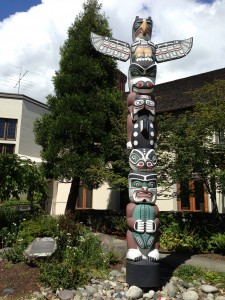This historical timeline is a really great way for students to learn about Canada’s history, alongside UBC’s history. Quite often, students feel a sense of distance when learning about history, thinking that it isn’t relevant to their lives today. However, looking at the timeline (which shows Aboriginal Students at UBC, Events at UBC, and BC/Canadian Context categories side-by-side), I found that I was able to relate a lot more to my country’s history because I recognized names like First Nations Longhouse and Totem Park under the “Aboriginal Students at UBC” column.
While comparing what was happening at UBC and Canada, I found that there were some discrepancies – it was surprising to see that at times, the history did not match. For example, in 1927, Musqueam house posts were presented to UBC as a gift, but in the same year, the government added Section 141 into the Indian Act, which did not allow Indians to hire lawyers or legal counsels. It seemed that the Musqueam were trying to be welcoming to UBC, but on a bigger scale, the government passed a bill where they were not allowed to fight for their rights. This was odd to me, but interesting at the same time to see how history and intentions can be so different in two places at the same point in time.
Going back to the idea that this timeline is much more “relatable” to students, I found it really fun to place myself in the timeline. I really enjoyed reading about what was happening when I was born, when I was in grade 1, and especially when my grandmother and mother were born. Since my family is from China, they did not know what was happening on this side of the earth. Yet, what was happening made a huge impact on their lives today. Placing myself in the timeline also made me realize how oblivious I was to everything that was happening around me. For example, in 1996, I was in grade 1 at 6-years-old. This was also the year that the last residential school closed. Knowing this fact now, I do not know why I was never taught about residential schools, especially when I, myself, was in school. It’s a very weird feeling realizing that when I was attending school without any problems, there were Aboriginal children attending schools too, but in a completely opposite setting.
I definitely learned a lot through this timeline and activity. History was quite “fun” when I put myself onto the timeline to see what was happening during those years. If I were to do this activity in the classroom, I would get my students to make a timeline of their own lives first (just to get used to the idea of what a timeline is), and then try to mesh their timeline with the Historical Timeline. I would set expectations that they choose a certain number of historical events to mesh onto their timeline, and to explain and reason why they chose those specific events. I want my students to be able to relate to history, and not just memorize it. Giving them a set number to put on their timeline will allow them to really focus on those events, really relate to it, and to reason why they chose it.

